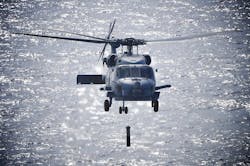Lockheed Martin to install AN/AQS-22 dipping sonar aboard 39 anti-submarine warfare (ASW) helicopters
PATUXENT RIVER NAS, Md. – Airborne anti-submarine warfare (ASW) experts at Lockheed Martin Corp. will install 39 AN/AQS-22 Airborne Low Frequency Sonar (ALFS) systems aboard U.S. Navy MH-60R helicopter under terms of a $181.7 million order announced Tuesday.
Officials of the Naval Air Systems Command at Patuxent River Naval Air Station, Md., are asking the Lockheed Martin Rotary and Mission Systems segment in Owego, N.Y., to install the Raytheon AN/AQS-22 ALFS on eight MH-60R helicopters for the Navy, 24 for India, and seven for Denmark.
The AN/AQS-22 ALFS is the primary undersea warfare sensor of the MH-60R multi-mission helicopter. This integrated dipping sonar system enables the MH-60R to detect, pinpoint, track, and classify enemy submarines. It also performs acoustic intercept, underwater communications, and environmental data acquisition.
The AN/AQS-22 has multi-frequency capability that enables the system to adapt its performance to varying environmental conditions. With a rapid search rate, the AN/AQS-22 identifies and neutralizes threats quickly, and to cover a large area.
The AN/AQS-22 also permits a long detection range over a wide area, reducing the number of helicopter sorties necessary to perform active airborne ASW screening, Raytheon officials say.
The dipping sonar system weighs 600 pounds, has a strong, safe, and reliable reeling system, and built-in fault monitoring. Raytheon, in partnership with Thales Underwater Systems, produces an average of 20 full-rate AN/AQS-22 production systems per year.
On this order Lockheed Martin will do the work in Brest, France; Portsmouth, R.I.; and Owego, N.Y., and should be finished by December 2024. For more information contact Lockheed Martin Rotary and Mission Systems online at www.lockheedmartin.com, or Naval Air Systems Command at www.navair.navy.mil.

John Keller | Editor-in-Chief
John Keller is the Editor-in-Chief, Military & Aerospace Electronics Magazine--provides extensive coverage and analysis of enabling electronics and optoelectronic technologies in military, space and commercial aviation applications. John has been a member of the Military & Aerospace Electronics staff since 1989 and chief editor since 1995.

